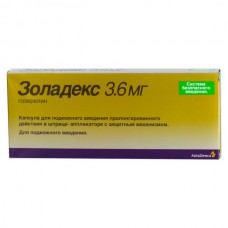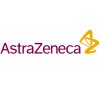Expiration date: 08/2026
The composition and form of issue:
Capsules for subcutaneous injection of prolonged action. 1 capsule contains:
goserelin acetate (in terms of goserelin base) 3.6 or 10.8 mg
auxiliary substances: copolymer of lactide and glycolide (50:50) of glacial acetic acid (removed in the production process)
1 capsule depot 3.6 mg in syringe applicator with a protective mechanism (system safety introduction Safety Glide). 1 syringe applicator is placed in the aluminum laminate envelope, the envelope in a cardboard box.
Description pharmaceutical form:
White or cream-colored cylindrical pieces of solid polymeric material, free or substantially free of visible inclusions.
Goserelin acetate is dispersed in exposed biological degradation of the matrix, consisting of lactide-glycolide copolymer. Comes with a syringe-single dose applicator with a protective mechanism (system safety introduction Safety Glide).
Pharmacokinetics:
Introduction capsules every 4 weeks ensures the maintenance of effective concentrations. Cumulation in the tissues takes place. The Zoladex is poorly protein bound, T1/2 from serum — 2-4 hours in patients with normal renal function. The half-life is increased in patients with impaired renal function. With a monthly injection of the drug this change will have significant consequences, so to change the dose for these patients is not required. In patients with hepatic impairment, significant changes in pharmacokinetics not observed.
Description pharmacological action:
The Zoladex is a synthetic analogue of the natural luteinizing hormone releasing hormone (LHRH). With regular use, the Zoladex inhibits the secretion of pituitary LH, which leads to lower concentrations of testosterone in serum in men and estradiol concentrations in serum in women. This effect is reversible after discontinuation of therapy. In the initial stage of the Zoladex, like other agonists lgrg, may cause a temporary increase in the concentration of testosterone in the blood serum in men and concentration of estradiol in the blood serum of the women. In the early stages of treatment with Zoladex some women may experience vaginal bleeding of varying duration and intensity.
In men by around 21 days after the introduction of the first capsule, the testosterone concentration is reduced to post-castration levels, and continues to be reduced with continuous treatment every 28 days. This decrease in the concentration of testosterone in most patients leads to regression of prostate tumors and to the symptomatic improvement.
In women the concentration of estradiol in serum has also been reduced to about 21 days after administration of the first capsule and, with regular administration of the drug every 28 days, remain reduced to a level comparable to that seen in women in menopause. This decline leads to positive effect in hormone-dependent breast cancer, endometriosis, fibroids of the uterus and inhibits the development of follicles in the ovaries. It also causes thinning of the endometrium and causes amenorrhea in the majority of patients.
It is shown that the Zoladex in combination with iron supplementation causes amenorrhoea and improve haemoglobin levels and the relevant haematological parameters in women with uterine fibroids and related anemia.
In patients receiving agonists LHRH in women can be menopause. Rarely, some women does not restore the menses after cessation of therapy.
Indications:
- prostate cancer
- breast cancer
- endometriosis
- uterine fibroids
- for thinning of the endometrium during the planned operations on the endometrium
- in-vitro fertilization.
Contraindications:
- hypersensitivity to goserelin or other analogues LHRH
- pregnancy
- lactation (breastfeeding)
- the children's age.
Application of pregnancy and breast-feeding:
Contraindicated in pregnancy. At the time of treatment should stop breastfeeding.
Side effects:
Noted rare cases hypersensitivity reactions, including some manifestations of anaphylaxis.
In patients, treated with Zoladex, sometimes the observed changes in blood pressure, manifest as hypotension or hypertension. These changes are usually transient and resolved or in the process of therapy with Zoladex or after its termination. In rare cases, these changes required medical intervention, including the abolition of Zoladex.
It was noted arthralgia. Were reported on the occurrence of nonspecific parasthesia. It was noted the appearance of a skin rash.
As with other drugs in this class, after the first administration of the drug in very rare cases, the reported occurrence of pituitary apoplexy.
The use of LHRH agonists in men may cause loss of mineral density of bone tissue.
To the side effects of Zoladex in men include "hot flashes", sweating and lower potency, seldom require discontinuation of therapy. Swelling and breast tenderness were observed infrequently. In the early treatment of patients with prostate cancer may experience temporary increased pain in the bones, which can be treated symptomatically. Noted individual cases of ureteral obstruction and compression of the spinal cord.
To the side effects of Zoladex in women include "hot flashes", sweating and change in libido, which rarely require discontinuation of therapy. Sometimes it was noted headaches, mood changes, including depression, dryness of the vaginal mucosa and change the size of the breast. In the initial stage of therapy, patients with breast cancer may experience a temporary boost in signs and symptoms of the disease are treated symptomatically. In women with uterine fibroids possible degeneration of fibromatous nodes. In rare cases, in the initial period of treatment in patients with breast cancer with bone metastases caused the hypercalcemia.
As with other analogues LHRH, with the use of Zoladex 3.6 mg in combination with gonadotropin have been reported for the development of ovarian hyperstimulation syndrome (SGSA). It is assumed that the desensitization caused by the use of Zoladex may lead in some cases to increase the dose of gonadotropin. It is necessary to carefully monitor the stimulation cycle to identify patients with risk of development of SGSY as the severity and frequency of the manifestations of the syndrome may depend on the dose regime gonadotropin. If required, the introduction of human chorionic gonadotropin should be stopped.
After using agonists lgrg reported the formation of follicular cysts and cysts of the corpus luteum. Most cysts are asymptomatic, functionally active, different size and resolve spontaneously.
Drug interactions:
It is not known.
Method of application and dose:
N/a in the anterior abdominal wall, adult, every 28 days.
Malignancy — long in benign gynecological diseases — more than 6 months for thinning of the endometrium — 2 injections with an interval of 4 weeks, while ablation of the uterus is recommended in the first 2 weeks after the second dose.
In vitro fertilization
The Zoladex (caps. 3.6 mg) is used for desensitization of the pituitary gland, which is determined by the concentration of estradiol in the blood serum. As a rule, the necessary level of estradiol, which corresponds to that in the early follicular phase of the cycle (approximately 150 pmol/l), obtained between 7 and 21 days. Upon the occurrence of desensitization begin the stimulation of superovulation (controlled ovarian stimulation) with gonadotrophin. Caused desensitization of the pituitary gland during the application of LHRH depot agonist may be more resistant, which could lead to increased requirement for gonadotrophin. At the appropriate stage of follicle development, the introduction of gonadotropin terminated and further for ovulation induction injected human chorionic gonadotropin. Monitoring treatment, procedure, retrieval of oocytes and fertilization are carried out in accordance with the established practice of this medical institution.
Elderly patients, patients with renal or hepatic impairment adjustment of the dose is not necessary.
Overdose:
Experience of overdose in humans is limited. Accidental injection of Zoladex ahead of time or in higher doses were observed clinically significant adverse events. Data regarding overdose in humans is not available.
Treatment: (in the case of overdose) — symptomatic therapy.
Precautions:
Prescribed with caution in men at particular risk of the occurrence of obstruction of the ureters or compression of the spinal cord. In these patients should be closely monitored during the first month of therapy. In that case, if the spinal cord compression or renal impairment due to ureteric obstruction are occurring or developing, you should assign common complications treatment.
During treatment and until recovery of menstruation should apply non-hormonal methods of contraception.
Currently available data on the use of the drug Zoladex have shown a reduction in average 4.6% of mineral bone density of the vertebrae within the 6-month treatment. Mineral density of bone tissue is gradually recovering after the end of treatment, remaining below the initial level on average by 2.6%. It has been shown that patients receiving Zoladex about endometriosis, additional hormone replacement therapy (a daily intake of estrogen and progestogen preparations) reduces the loss of mineral bone density and the severity of vasomotor symptoms.
Resumption of menstruation after the end of treatment with Zoladex some patients may be delayed. In rare cases, some women during treatment analogues LHRH can take place menopause without recovery of menstruation after cessation of therapy.
The use of Zoladex may lead to an increase in cervical resistance, care must be taken when dilatation of the cervix.
There is no data on the efficacy and safety of treatment with Zoladex lasting more than 6 months for benign gynecological diseases.
The Zoladex should be used with in vitro fertilization only under the supervision of a specialist having experience in this field.
Be used with caution in-vitro fertilization in patients with polycystic ovary syndrome because of possible stimulation of a large number of follicles.



